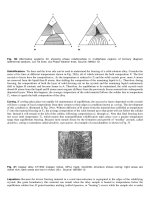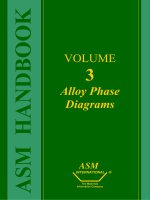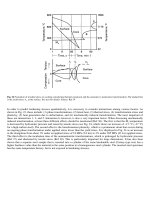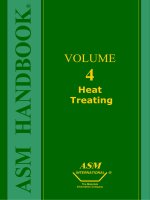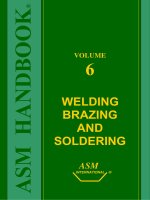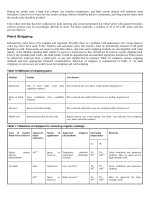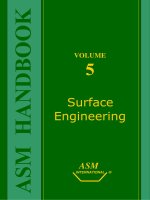ASM Metals HandBook P6
Bạn đang xem bản rút gọn của tài liệu. Xem và tải ngay bản đầy đủ của tài liệu tại đây (462.5 KB, 10 trang )
Fig. 30 Alternative systems for showing phase relationships in multiphase regions of ternary diagram
isothermal sections. (a) Tie lines. (b) Phase-fraction lines. Source: 84Mor 12
Solidification. Tie lines and the lever rule can be used to understand the freezing of a solid-solution alloy. Consider the
series of tie lines at different temperatures shown in Fig. 29(b), all of which intersect the bulk composition X. The first
crystals to freeze have the composition α
1
. As the temperature is reduced to T
2
and the solid crystals grow, more A atoms
are removed from the liquid than B atoms, thus shifting the composition of the remaining liquid to L
2
. Therefore, during
freezing, the compositions of both the layer of solid freezing out on the crystals and the remaining liquid continuously
shift to higher B contents and become leaner in A. Therefore, for equilibrium to be maintained, the solid crystals must
absorb B atoms from the liquid and B atoms must migrate (diffuse) from the previously frozen material into subsequently
deposited layers. When this happens, the average composition of the solid material follows the solidus line to temperature
T
4
, where it equals the bulk composition of the alloy.
Coring. If cooling takes place too rapidly for maintenance of equilibrium, the successive layers deposited on the crystals
will have a range of local compositions from their centers to their edges (a condition known as coring). The development
of this condition is illustrated in Fig. 29(c). Without diffusion of B atoms from the material that solidified at temperature
T
1
into the material freezing at T
2
, the average composition of the solid formed up to that point will not follow the solidus
line. Instead it will remain to the left of the solidus, following compositions α'
1
through α'
5
. Note that final freezing does
not occur until temperature T
5
, which means that nonequilibrium solidification takes place over a greater temperature
range than equilibrium freezing. Because most metals freeze by the formation and growth of "treelike" crystals, called
dendrites, coring is sometimes called dendritic segregation. An example of cored dendrites is shown in Fig. 31.
Fig. 31 Copper alloy C71500 (copper nickel, 30%) ingot. Dendritic structure shows coring: light areas are
nickel rich; dark areas are low in nickel. 20×. Source: 85ASM 13
Liquation. Because the lowest freezing material in a cored microstructure is segregated to the edges of the solidifying
crystals (the grain boundaries), this material can remelt when the alloy sample is heated to temperatures below the
equilibrium solidus line. If grain-boundary melting (called liquation, or "burning") occurs while the sample also is under
stress, such as during hot forming, the liquefied grain boundaries will rupture and the sample will lose its ductility and be
characterized as hot short.
Liquation also can have a deleterious effect on the mechanical properties (and microstructure) of the sample after it
returns to room temperature. This is illustrated in Fig. 29(d) for a homogenized sample. If homogenized alloy X is heated
into the liquid-plus-solid region for some reason (inadvertently or during welding, etc.), it will begin to melt when it
reaches temperature T
2
; the first liquid to appear will have the composition L
2
. When the sample is heated at normal rates
to temperature T
1
, the liquid formed so far will have a composition L
1
, but the solid will not have time to reach the
equilibrium composition α
1
. The average composition will instead lie at some intermediate value, such as α'
1
. According
to the lever rule, this means that less than the equilibrium amount of liquid will form at this temperature. If the sample is
then rapidly cooled from temperature T
1
, solidification will occur in the normal manner, with a layer of material having
composition α
1
deposited on existing solid grains. This is followed by layers of increasing B content up to composition α
3
at temperature T
3
, where all of the liquid is converted to solid. This produces coring in the previously melted regions
along the grain boundaries, and sometimes even voids that decrease the strength of the sample. Homogenization heat
treatment will eliminate the coring, but not the voids.
Eutectic Microstructures. When an alloy of eutectic composition (such as alloy 2 in Fig. 28) is cooled from the liquid
state, the eutectic reaction occurs at the eutectic temperature, where the two distinct liquidus curves meet. At this
temperature, both α and βsolid phases must deposit on the grain nuclei until all of the liquid is converted to solid. This
simultaneous deposition results in microstructures made up of distinctively shaped particles of one phase in a matrix of
the other phase, or alternate layers of the two phases. Examples of characteristic eutectic microstructures include
spheroidal, nodular, or globular; acicular (needles) or rod; and lamellar (platelets, Chinese script or dendritic, or filigreed).
Each eutectic alloy has its own characteristic microstructure when slowly cooled (see Fig. 32). More rapid cooling,
however, can affect the microstructure obtained (see Fig. 33). Care must be taken in characterizing eutectic structures,
because elongated particles can appear nodular and flat platelets can appear elongated or needlelike when viewed in cross
section.
Fig. 32 Examples of characteristic eutectic microstructures in slowly cooled alloys. (a) 50Sn-50ln alloy showing
globules of tin-rich intermetallic phase (light) in a matrix of dark indium-rich intermetallic phase. 150×. (b) Al-
13Si alloy showing an acicular structure consisting of short, angular particles of silicon (dark) in a matrix of
aluminum. 200×. (c) Al-33Cu alloy showing a lamellar structure consisting of dark platelets of CuAl
2
and light
platelets of aluminum solid solution. 180×. (d) Mg-37Sn alloy showing a lamellar structure consisting of Mg
2
Sn
"Chinese script" (dark) in a matrix of magnesium solid solution. 250×. Source: 85ASM 13
Fig. 33 Effect of cooling rate on the microstructure of Sn-37Pb alloy (eutectic soft solder). (a) Slowly cooled
sample shows a lamellar structure consisting of dark platelets of lead-rich solid solution and light platelets of
tin. 375×. (b) More rapidly cooled sample shows globules of lead-rich solid solution, some of which exhibit a
slightly dendritic structure, in a matrix of tin. 375×. Source: 85ASM 13
If the alloy has a composition different from the eutectic composition (such as alloy 1 or 3 in Fig. 28), the alloy will begin
to solidify before the eutectic temperature is reached. If the alloy is hypoeutectic (such as alloy 1), some dendrites of α
will form in the liquid before the remaining liquid solidifies at the eutectic temperature. If the alloy is hypereutectic (such
as alloy 3), the first (primary) material to solidify will be dendrites of β. The microstructure produced by slow cooling of a
hypoeutectic and hypereutectic alloy will consist of relatively large particles of primary constituent, consisting of the
phase that begins to freeze first surrounded by relatively fine eutectic structure. In many instances, the shape of the
particles will show a relationship to their dendritic origin (see Fig. 34a). In other instances, the initial dendrites will have
filled out somewhat into idiomorphic particles (particles having their own characteristic shape) that reflect the crystal
structure of the phase (see Fig. 34b).
Fig. 34 Examples of primary particle shape. (a) Sn-30Pb hypoeutectic alloy showing dendritic particles of tin-
rich solid solution in a matrix of tin-lead eutectic. 500×. (b) Al-19Si hypereutectic alloy, phosphorus-modified,
showing idiomorphic particles of silicon in a matrix of aluminum-silicon eutectic. 100×. Source: 85ASM 13
As stated earlier, cooling at a rate that does not allow sufficient time to reach equilibrium conditions will affect the
resulting microstructure. For example, it is possible for an alloy in a eutectic system to obtain some eutectic structure in
an alloy outside the normal composition range for such a structure. This is illustrated in Fig. 35. With relatively rapid
cooling of alloy X, the composition of the solid material that forms will follow line α
1
-α'
4
rather than the solidus line to α
4
.
As a result, the last liquid to solidify will have the eutectic composition L
4
, rather than L
3
, and will form some eutectic
structure in the microstructure. The question of what takes place when the temperature reaches T
5
is discussed later.
Fig. 35 Schematic binary phase diagram, illustrating the effect of cooling rate on an alloy lying outside the
equilibrium eutectic transformation line. Rapid solidification into a terminal phase field can result in some
eutectic structure being formed; homogenization at temperatures in the single-phase field will eliminate the
eutectic structure; β phase will precipitate out of solution upon slow cooling into the α-plus-β field. Source:
Adapted from 56Rhi 3
Eutectoid Microstructures. Because the diffusion rates of atoms are so much lower in solids than in liquids,
nonequilibrium transformation is even more important in solid/solid reactions (such as the eutectoid reaction) than in
liquid/solid reactions (such as the eutectic reaction). With slow cooling through the eutectoid temperature, most alloys of
eutectoid composition, such as alloy 2 in Fig. 36, transform from a single-phase microstructure to a lamellar structure
consisting of alternate platelets of α and β arranged in groups (or "colonies"). The appearance of this structure is very
similar to lamellar eutectic structure (see Fig. 37). When found in cast irons and steels, this structure is called "pearlite"
because of its shiny mother-of-pearl appearance under the microscope (especially under oblique illumination); when
similar eutectoid structure is found in nonferrous alloys, it often is called "pearlite-like" or "pearlitic."
Fig. 36 Schematic binary phase diagram of a eutectoid system. Source: Adapted from 56Rhi 3
Fig. 37 Fe-0.8C alloy showing a typical pearlite eutectoid structure of alternate layers of light ferrite and dark
cementite. 500×. Source: 85ASM 13
The terms hypoeutectoid and hypereutectoid have the same relationship to the eutectoid composition as hypoeutectic and
hypereutectic do in a eutectic system; alloy 1 in Fig. 36 is a hypoeutectoid alloy, whereas alloy 3 is hypereutectoid. The
solid-state transformation of such alloys takes place in two steps, much like the freezing of hypoeutectic and
hypereutectic alloys, except that the microconstituents that form before the eutectoid temperature is reached are referred
to as proeutectoid constituents rather than "primary."
Microstructures of Other Invariant Reactions. Phase diagrams can be used in a manner similar to that described
in the discussion of eutectic and eutectoid reactions to determine the microstructures expected to result from cooling an
alloy through any of the other six types of reactions listed in Table 1.
Solid-State Precipitation. If alloy X in Fig. 35 is homogenized at a temperature between T
3
and T
5
, it will reach an
equilibrium condition; that is, the β portion of the eutectic constituent will dissolve and the microstructure will consist
solely of α grains. Upon cooling below temperature T
5
, this microstructure will no longer represent equilibrium
conditions, but instead will be supersaturated with B atoms. In order for the sample to return to equilibrium, some of the
B atoms will tend to congregate in various regions of the sample to form colonies of new β material. The B atoms in some
of these colonies, called Guinier-Preston zones, will drift apart, while other colonies will grow large enough to form
incipient, but not distinct, particles. The difference in crystal structures and lattice parameters between the α and β phases
causes lattice strain at the boundary between the two materials, thereby raising the total energy level of the sample and
hardening and strengthening it. At this stage, the incipient particles are difficult to distinguish in the microstructure.
Instead, there usually is only a general darkening of the structure. If sufficient time is allowed, the β regions will break
away from their host grains of α and precipitate as distinct particles, thereby relieving the lattice strain and returning the
hardness and strength to the former levels. This process is illustrated for a simple eutectic system, but it can occur
wherever similar conditions exist in a phase diagram; that is, there is a range of alloy compositions in the system for
which there is a transition on cooling from a single-solid region to a region that also contains a second solid phase, and
where the boundary between the regions slopes away from the composition line as cooling continues. Several examples of
such systems are shown schematically in Fig. 38.


